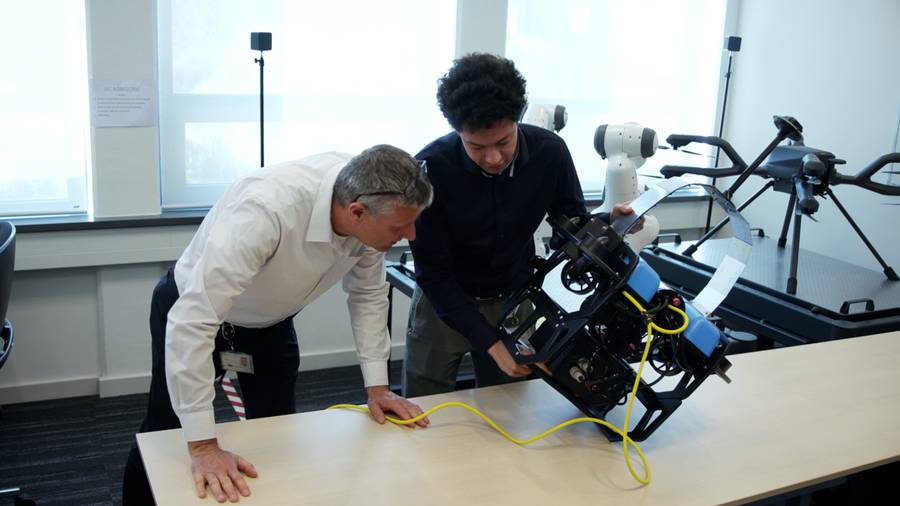
Autonomous operation is currently not possible because the Global Positioning System (GPS), a crucial source of positioning information on land and in the air, is not available underwater.
'Budget' positioning systems
The performance of more affordable positioning system sensors has significantly improved in recent years. However, fully integrated 'budget' positioning systems are currently not available for small underwater vehicles.
TNO is developing a small and inexpensive positioning system to meet the growing demand for autonomy in hydrography. The positioning system combines and processes data from various sensors in real-time to provide robust position information using the specially developed Timing, Orientation & Positioning Service (TOPS) software. This groundbreaking solution has the potential to automate tasks for monitoring and inspecting underwater ROVs at a cost of less than €10,000.
AURO
Danny Maat, as the projectmanager of Intelligent Autonomous Systems at TNO, is responsible for the Autonomous Underwater Remote Operations (AURO) project. He has been working at TNO for over 26 years and finds it a great challenge to develop and apply new technologies.
"The AURO project is still in its early stages, but we have already made significant progress. It is wonderful to be part of a project in which a knowledge institution and the business sector join forces to stimulate new developments together. We are working on a system that needs to combine two unique characteristics: reliable underwater navigation and high-quality autonomy."
Experiment
In this project, we expanded the compact and affordable BlueRobotics ROV, the BlueROV2, with a waterproof box. The box contains various sensors and a computer. "TOPS software is installed on the computer to process the sensor data. Additionally, a GPS antenna is mounted on top of the ROV," explains Jim Rojer, Systems Engineer and Navigation Expert at TNO. "A structure was designed for the mounting of the GPS antenna, allowing the antenna to protrude above the water surface during experiments. This allowed the BlueROV2 to be fully submerged while maintaining an accurate GPS signal. This made it possible to perform a calibration phase before the mission, during which TOPS could estimate sensor properties. A calibration time of about 90 seconds proved sufficient for the BlueROV2 to safely dive underwater and perform its mission."
"The goal was to develop a budget positioning solution that combines cheaper sensors with advanced sensor fusion methods," says Danny Maat. "In general, budget sensors will have lower specifications and will be more affected by varying environmental conditions." The philosophy was to use sensor fusion to estimate sensor properties in a preceding calibration phase and then compensate for these effects, achieving a performance that is 'almost high-end'. Validation tests were conducted in the port of Scheveningen, part of the Test Bed in the North Sea, a designated area for conducting experiments, to evaluate the system's performance.

Autonomy
After calibration, the GPS was no longer used by TOPS but only served as a reference signal to assess the performance of TOPS' position determination.
To demonstrate the value of innovation for technology integrators and end-users, a simple autopilot function was developed to autonomously guide the BlueROV2 along a preplanned route at a fixed depth. During the demonstration, a pattern resembling that of a lawnmower was used to simulate seabed inspection. The results of the validation tests in the port of Scheveningen showed that the developed navigation solution was capable of accurately determining the position of the BlueROV2, even without using GPS. The performance is comparable to that of more advanced and larger systems, but at a lower cost.
The next phase
To further enhance the developed navigation solution, improvements can be made to the calibration phase and the integration of additional sensors. Refining the autopilot function and integrating advanced planning techniques are also crucial steps for further development.
Max Schellenbach, Manager of Inshore & Nearshore Diving Services at Boskalis, sees AURO as a game-changer. "This continuous development and improvement of the navigation solution offer possibilities for affordable high-end solutions for small ROVs and autonomous underwater navigation capabilities. This opens up new perspectives for efficient inspection and monitoring of underwater assets in various sectors, including offshore wind farms, cables, quay walls, locks, and more."
Partners
TKI Offshore Energy has contributed to making this project possible. TNO and its partners, including Boskalis, are eager to move on to practical testing. "Through the development of AURO, Boskalis can deploy its divers more strategically for specialized tasks, especially because the company believes that finding specialized divers will become increasingly difficult in the future," explains Max Schellenbach. "The direct availability of data transmitted by the ROV is a major advantage. Additionally, such advanced technological solutions can be operational 24/7, and skilled, scarce, personnel are not."
This article is a part of the Project in the Spotlight series. You can watch more here.
